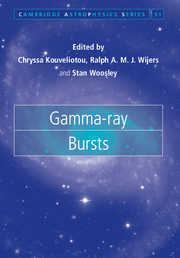Book contents
- Frontmatter
- Contents
- List of contributors
- Prologue
- 1 The discovery of the gamma-ray burst phenomenon
- 2 Instrumental principles
- 3 The BATSE era
- 4 The cosmological era
- 5 The Swift era
- 6 Discoveries enabled by multiwavelength afterglow observations of gamma-ray bursts
- 7 Prompt emission from gamma-ray bursts
- 8 Basic gamma-ray burst afterglows
- 9 The GRB–supernova connection
- 10 Models for gamma-ray burst progenitors and central engines
- 11 Jets and gamma-ray burst unification schemes
- 12 High-energy cosmic rays and neutrinos
- 13 Long gamma-ray burst host galaxies and their environments
- 14 Gamma-ray burst cosmology
- 15 Epilogue
- Indix
- Plate section
- References
8 - Basic gamma-ray burst afterglows
Published online by Cambridge University Press: 05 December 2012
- Frontmatter
- Contents
- List of contributors
- Prologue
- 1 The discovery of the gamma-ray burst phenomenon
- 2 Instrumental principles
- 3 The BATSE era
- 4 The cosmological era
- 5 The Swift era
- 6 Discoveries enabled by multiwavelength afterglow observations of gamma-ray bursts
- 7 Prompt emission from gamma-ray bursts
- 8 Basic gamma-ray burst afterglows
- 9 The GRB–supernova connection
- 10 Models for gamma-ray burst progenitors and central engines
- 11 Jets and gamma-ray burst unification schemes
- 12 High-energy cosmic rays and neutrinos
- 13 Long gamma-ray burst host galaxies and their environments
- 14 Gamma-ray burst cosmology
- 15 Epilogue
- Indix
- Plate section
- References
Summary
Introduction
As we have seen in the previous chapters, observational evidence combined with elementary theoretical considerations leads to the view that gamma-ray bursts (GRBs) and their afterglows result from dissipation of energy from an ultrarelativistic flow, which in turn is generated by a catastrophic event that injects a supernova-like amount of energy into a small volume. As discussed in Chapter 7, this dissipation can be both internal (when radial or angular differences in motion lead to heat production and subsequent radiation) and external (when the outflow interacts with its environment). The prevailing view attributes the prompt gamma-ray emission to the internal dissipation, and the afterglow to external dissipation, but the phenomena may overlap in time. A case in point is the so-called reverse-shock emission seen in optical wavelengths, during and soon after the prompt emission, and in radio wavelengths within the first days (Chapters 6 and 7), which is best explained as due to the reverse shock propagating back into the ejecta when they decelerate onto the external mass. The present chapter will deal with the physics of the external interaction of the outflow, regardless of how soon after the burst onset we see its emission.
There are some basic assumptions we make about the physics that dominates the behavior of our system. First, we will here treat only the spherically symmetric case. This is generally not correct, because GRBs are known to be highly collimated.
- Type
- Chapter
- Information
- Gamma-ray Bursts , pp. 151 - 168Publisher: Cambridge University PressPrint publication year: 2012
References
- 1
- Cited by



